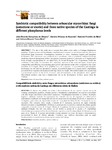Por favor, use este identificador para citar o enlazar este ítem:
http://www.alice.cnptia.embrapa.br/alice/handle/doc/1069379Registro completo de metadatos
| Campo DC | Valor | Lengua/Idioma |
|---|---|---|
| dc.contributor.author | OLIVEIRA, J. R. G. de | pt_BR |
| dc.contributor.author | RESENDE, G. M. de | pt_BR |
| dc.contributor.author | MELO, N. F. de | pt_BR |
| dc.contributor.author | MELO, A. M. Y. | pt_BR |
| dc.date.accessioned | 2017-05-09T11:11:11Z | pt_BR |
| dc.date.available | 2017-05-09T11:11:11Z | pt_BR |
| dc.date.created | 2017-05-09 | pt_BR |
| dc.date.issued | 2017 | pt_BR |
| dc.identifier.citation | Acta Scientiarum. Biological Sciences, Maringá, v. 39, n. 1, p. 59-69, jan./mar., 2017, | pt_BR |
| dc.identifier.issn | 1807-863X | pt_BR |
| dc.identifier.uri | http://www.alice.cnptia.embrapa.br/alice/handle/doc/1069379 | pt_BR |
| dc.description | The aim of this study was to evaluate three plant species native to Caatinga (Aspidosperma pyrifolium, Ziziphus joazeiro and Pseudobombax simplicifolium) in response to inoculation with two arbuscular mycorrhizal fungi (autoctone: Claroideoglomus etunicatum or exotic: Acaulospora longula) and phosphate fertilization. The experiment was conducted in a greenhouse with a completely randomized design involving a factorial arrangement of three inoculation treatments control, C. etunicatum or A. longula ) and 4 levels of single superphosphate (0 - no added P 2 O 5 , 12, 24 and 48 mg dm -3 ) in 10 repetitions. Under the conditions of this study, the inoculum of C. etunicatum , autoctone to the semi-arid region, showed great compatibility and efficiency in promoting plant growth and nutrient intake when compared to the exotic inoculum of A. longula. Plants of A. pyrifolium were not responsive to mycorrhization and hosphate fertilization. In soil with low phosph orus content, mycorrhized plants of Z. joazeiro and P. simplicifolium presented better vegetative development with high shoot dry weight. Mycorrhized plants of Z. joazeiro had a proportional increase in the levels of macro- an d micronutrients at the phosphorus doses applied. Mycorrhizal symbiosis may have a fundamental role in the development of these species from the Caatinga. | pt_BR |
| dc.language.iso | eng | eng |
| dc.rights | openAccess | eng |
| dc.subject | Fungos micorrízicos arbusculares | pt_BR |
| dc.subject | Semiárido | pt_BR |
| dc.subject | Pseudobombax simplicifolium | pt_BR |
| dc.subject | Espécies endêmicas | pt_BR |
| dc.subject | Native species | pt_BR |
| dc.title | Symbiotic compatibility between arbuscular mycorrhizal fungi (autoctone or exotic) and three native species of the Caatinga in different phosphorus levels. | pt_BR |
| dc.type | Artigo de periódico | pt_BR |
| dc.date.updated | 2017-05-09T11:11:11Z | pt_BR |
| dc.subject.thesagro | Espécie nativa | pt_BR |
| dc.subject.thesagro | Caatinga | pt_BR |
| dc.subject.thesagro | Micorriza | pt_BR |
| dc.subject.thesagro | Aspidosperma Pyrifolium | pt_BR |
| dc.subject.thesagro | Micorriza Vesicular Arbuscular | pt_BR |
| dc.subject.thesagro | Ziziphus Joazeiro | pt_BR |
| dc.subject.nalthesaurus | Indigenous species | pt_BR |
| riaa.ainfo.id | 1069379 | pt_BR |
| riaa.ainfo.lastupdate | 2017-05-09 | pt_BR |
| dc.identifier.doi | 10.4025/actascibiolsci.v39i1.33486 | pt_BR |
| dc.contributor.institution | JOÃO RICARDO GONÇALVES DE OLIVEIRA, UFPE; GERALDO MILANEZ DE RESENDE, CPATSA; NATONIEL FRANKLIN DE MELO, CPATSA; ADRIANA MAYUMI YANO MELO, UNIVASF. | pt_BR |
| Aparece en las colecciones: | Artigo em periódico indexado (CPATSA)  | |
Ficheros en este ítem:
| Fichero | Descripción | Tamaño | Formato | |
|---|---|---|---|---|
| nATONIEL2017.pdf | 931.49 kB | Adobe PDF |  Visualizar/Abrir |









